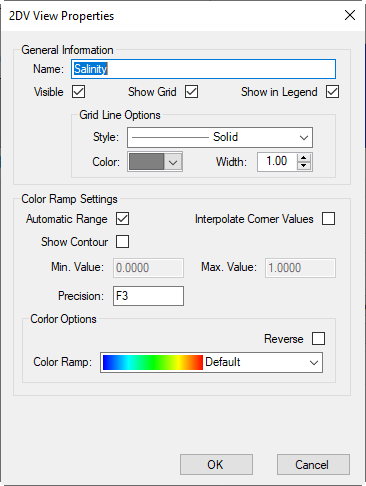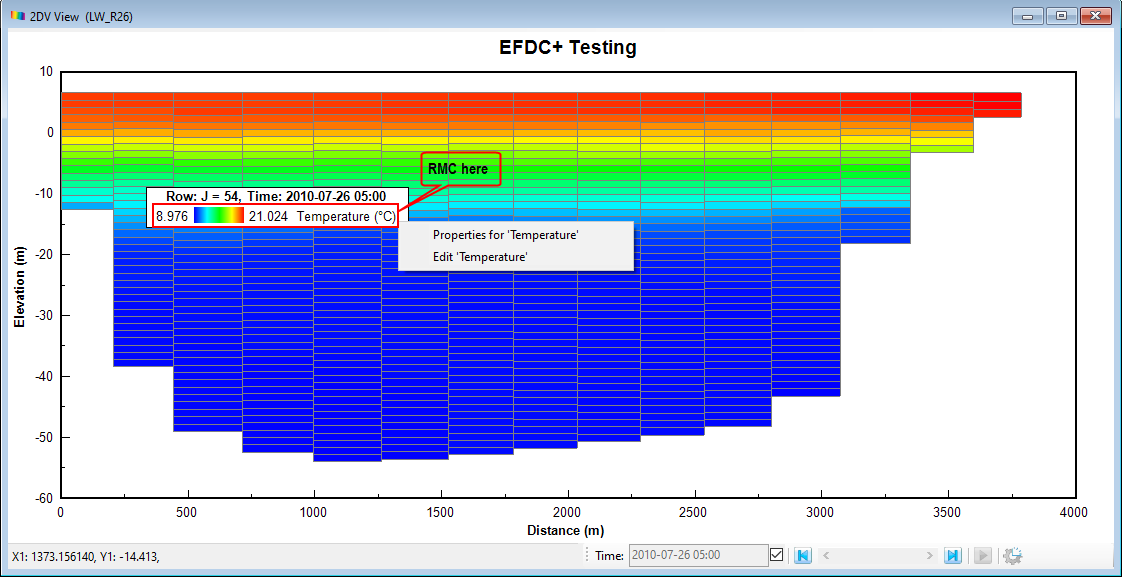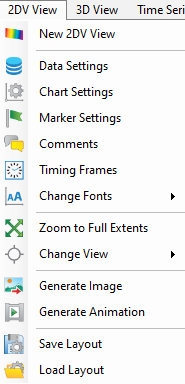The 2DV View button and the icon of the main toolbar provides access to the profile/cross section post-processing utility of EE as shown in Figure 1. This option was called ViewSlice in previous versions of EE.
...
The Profile Definition frame needs to be set before a profile can be extracted from EFDC. There are three options shown in Figure 2. The user may either select a value of I to extract the active J cells along that I, or select a value of J to extract the active I cells along that J. The third option is to use a "Drape Line", which is a polyline in the same coordinate system as the LX, LY data. The I & J's along this line will be assembled and the profile will be output along that slice. If an I or J extraction is used, the user can scroll up and down the select a coordinate.
The user select should then select which parameters are to be displayed in Define Parameter to Plot frame. First choose the Primary Group, then the necessary Parameter from that group and select the left arrow button . The user may select more than one parameter to plot. The parameters selected are displayed in Parameters to Plot frame, where the user can also remove the parameter by using the right arrow button save current 2DV layout, load an external 2DV layout or move the layers up and down. This will change the order in which layers are drawn by EE. The Update button will replace the currently highlighted parameters in Parameters to Plot frame with the currently selected parameters in Define Parameter to Plot frame. The Properties button will open the 2DV View Properties form where the user can configure the color ramp, contour, precision, range and other settings (Figure 3). Click OK to plot 2DV View.
Anchor Figure 3 Figure 3
Figure 3. 2DV View Properties form.
An example of the plot is shown in Figure 4. Information about the current cell can be displayed (the yellow text box), as in 2DH View, by LMC on the cell. Many of the operations of this feature are similar to 2DH View.
...
If the user RMCs on the bottom of the legend (highlighted in Figure 6), the user can select Properties and Edit for the current parameter, choose Properties will open the 2DV View Properties (Figure 3) while Edit will open the Data Extraction for 2DV View (Figure 2)
Anchor Figure 6 Figure 6
Figure 6. RMC on the bottom of legend box.
...
With the 2DV View window selected as the current window, clicking on 2DV View on the main toolbar will show additional menu items (Figure 7). These items provide the user with helpful functions like markers, comments, control view, import and export data series as described below.
| Anchor | ||||
|---|---|---|---|---|
|
Figure 7. 2DV View toolbar menu.
...
As with the 2DH View, the user can export images and animations from the plot with Generate Image and Generate Animation.
Generate Image: the user should select a name for the image and select the folder to save out the image by clicking Browse button then click OK button to finish, by default the image will be saved in #analysis folder of the active model.
Generate Animations: displays the Generate Bitmap/Animation form, by default the animation will be saved in #animations folder of the active model. Alternatively, the user can set name for the animation and folder to save out the image by clicking Browse button. Setting options for the animation file can be applied in this form such as start/stop animation timing, and number of time steps to skip. Finally click OK button to start exporting the file (see Figure 8).
The results of any of the time dependent results can be output as an animation to an AVI file. If the animation is to be saved to an AVI file, the user is asked for the number of frames per second to be output to the file. This will be application specific, but a number of 4 frames per second generally provides a fairly smooth, but not too fast animation. The user should be aware that these files can get quite large quickly. The frame size of the animation will match the frame of the 2DH View. Press the "Escape" key to stop an animation.
Anchor Figure 8 Figure 8
Figure 8. Export animations.




